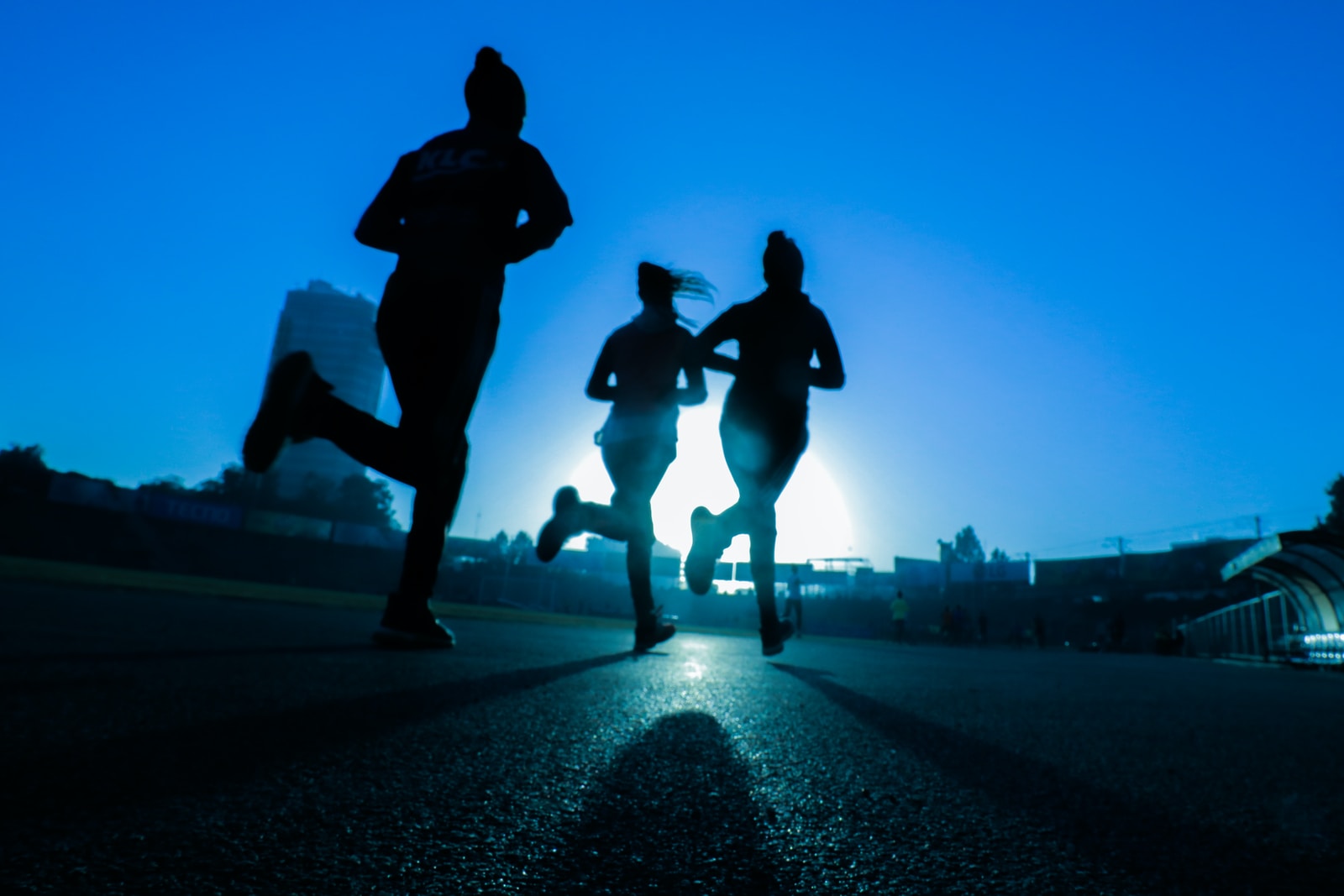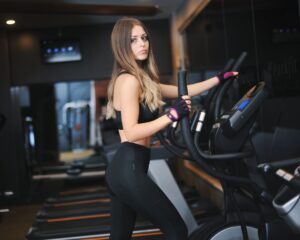This is a follow up post from the last issue’s post on cool weather workouts. Cold weather running is its own art form, and this post explains everything you need to know about timing, gear, injury prevention and recovery. This post is guest authored by a real life devoted runner and former track and field star, my friend and longtime trainer, Neda Khalili.
If I call Neda, and she doesn’t pick up, I pretty much know it’s because she’s running. She loves it that much. And she will run, rain or shine, cold or hot, so she is the subject matter expert in how to not lose motivation for running as the temps drop. Whether you dabble in jogging, are a devoted runner, or just want to be able to work out without wearing a mask, this is the complete guide for you. It also applies to walking!

The art of running in cold weather
Running should never be painful and although it can be challenging, adding to that special grit does not have to include the pain of cold weather! How is that possible? Well, today I will let you in some ways that running in cold weather *can* feel the same as a pleasant spring or fall day. No temperature is technically ‘too cold’ to run in where it presents fatalities the same way that hot weather presents, however one can still be susceptible to frostbite or if icy conditions are present, those can be fatal and/or completely life altering injuries. Luckily, there are a lot of resources out there to make cold weather running enjoyable and quite easy and today I will expound upon that quite a bit. In fact, for those who are seasoned runners, a study was found that running in the cold actually improves one’s overall running performance!
Keeping your body warm
All of your tentacles (including your head!) must have coverage! Finding the balance of what works for you is key as everyone’s body is different in terms of keeping yourself safely insulated. My suggestions are to start at a shorter distance if you are new to running in the cold and see how your body may respond at first. Hat, gloves, and the right socks are really non-negotiable in terms of frostbite prevention. I will explain these ever important accessory necessities, as well as, base layers for core and legs, and other tips. Base layers may change from person to person and you may very well be a person that needs shorts and a sports bra on a summer day to be absolutely covered up the moment it is 50 degrees. There are other factors, such as anemia and/or vitamin D deficiency that also may influence your bundling choices where you may find yourself almost always cold, for that, I say opt for more layers until you find the right combination for you. Luckily with innovations of exercise science, there are so many choices that help keep you cozy with minimal layering (we are looking at you, washable Merino wool, nylon, and aerogels)! Ahhh, the beauty of science for us all!
Your core body temperature (really your torso and upper legs) will heat up the fastest. Your ears, fingers, and toes; this one should be covered as it is with shoes but we all know when the temperature drops it is all about thick and fuzzy socks. You do lose ten percent of your body heat through your head, so having your head covered invites a much more pleasant running experience ahead. A smartwool hat is a good start and a tiny investment to make for more future runs. Smartwool is particularly nice because it is a Merino wool that particles are so fine that it does not give off the typical itch and you can easily wash it without worrying if it turned into a fun sized toy! Wool is also a material that is naturally water repellent and keeps out the excess moisture of biting cold times. Merino wool is washable and if you are not quite the fan of hats, Lululemon has a great headband ear covering that will keep your ears safe from frostbite; it is nice and wide without being in the way.
Gore-Tex is also another material made up of a very tight knit nylon that keeps out moisture and cold. Gore-Tex is the trademarked name brand for very tightly woven polyester nylon threads woven together and 3M’s Thinsulate is the name thing under the name “Ripstop.” If you see those two names, you have a trusted covering. What is interesting to note and ever-changing is that science of keeping you warm! Although these are very thin materials, breathable, packable, yet durable because of their nature in keeping away moisture and cold, you are able to focus on having a smoother run, not over heating yourself with having a down jacket on but instead a trusty thermal! Not only are these fabrics relatively inexpensive but they are easily accessible, packable, more sustainable for the environment as a down alternative, and are actually on par with down fill insulation. Personally, I like North Face’s Eco Primaloft thermoball line, as it is light and breathable. They have options with vests, as well which would pair quite well with thermal baselayers.
Last week I talked about thermals a bit and their importance as a tool to get you out of the door and going. They are certainly the most important piece for keeping you warm and in conjunction with the right jacket, keeping you comfortable without overheating yourself too much. Here is where things really come down to your own personal preference. I would start with a heavier weight base layer thermal to see if your body really heats up too much or not. I have been running in Nike Pro line thermals since the age of 12 and when the temperature drops, I reach for the heavier weight mock turtleneck or the ¼ zipper tops and they have those wonderful thumbholes so that I can focus on my form. Some prefer something a bit lighter or medium weight which is also breathable and for that I would suggest a polyester to such as Patagonia’s Capilene Crew. I use this top the moment that I feel that I feel the sensitivity of the cold aka late fall and early spring and it has served me quite well in its breathability and also durability. Both the Nike Pro Line and Patagonia do an excellent job of find a fit that keeps you insulated yet able to move well.
Last but not least are your legs! This is where all of the action is happening! For here, I am actually going to start with your feet because this is the most vulnerable. Once again, Merino wool hits the home run and these are actually soft and cashmere-like! A very trustworthy choice and a pair that you can use all year round (or if you are on the East Coast with mood swings in weather) is SmartWool PhD Run Cold and Crosspoint’s Wool Waterproof Socks. Keeping your feet dry and insulated is the first step you can take. Many running shoes have seen the necessity over the years to make thicker winter running shoes. Finding the right running shoe can be challenging in and of itself but in recent years, Nike has decided to make some Wool Roshes, Saloman and Northface both make more heavily insulated running shoes, but the some potentially better options out there might be to Hoka with a platform elevation, literally boosted away from the ground. I do realize that running shoes are a very personal choice and I really stick with the running shoes that work best for me which are not winter based (Nike Free Run) but up my sock game!
Interestingly enough, although it is very important to have your whole body covered, the base layer of your legs comes last in importance rankings. This is in part because the fire and heat is being created by the power of them, your legs are your own personal heated motor! When you are running in motion, your legs are generating heat for your whole body. This is why having a base layer for your legs is really up to personal preference and why you may see some people running in shorts but the rest of their body covered. Personally, when it is cold, I like to retain as much heat as I can and the mere thought of going out the door without such is miserable and I do opt for a thicker pair of running leggings.

Warm up to warm up
The reason why this last part is not seemingly as vital is because you are literally doing the vital working heat. With a proper warm up, (jogging at any easy pace for a few minutes) and dynamic, active stretching and/or running drills, and your actual run. The key is to keep moving from essentially leaving your door to getting back into your door! Your cooldown should only be a few minutes of an easy pace that eventually transitions into an easy walk of a minute or two because once you get back inside, immediately take your sweaty cold gear off and shower. Once you have showered, then take a few minutes to foam roll before carrying on with the rest of your day or night. It may seem like a little bit of a different scheme of cooling down than what you are used to but that is because the window your body loses heat very, very rapidly and in those few minutes it is vital to keep yourself warm so that you do not catch a cold.
If you feel that it is just too cold or that your body is too miserable to run outside, there are plenty of indoor options that I will detail in a later post; from the gym to YouTube! I always say to take a more conservative approach when there is ice and sleet outside (it is a hard ‘NO!’ for hail) because it is always better safe than sorry and being sidelined with injury into the spring again would be quite painful and miserable. Always listen to your body, use your best judgement to be safe, and take the time to see what works best for you as it really may be different from person to person.
You may even want to consider a short run after a yoga class, where your muscles are already warmed up and limber. See this post from Lily Trotters (no relation to THIS Lili).

A Few Notes on Timing of your Run
If you are an early morning or evening runner, just like you would prepare for a day’s work knowing what you are going to wear due to weather- the same goes for knowing what the next day’s forecast is for your run, so plan accordingly! Staying as informed as you possibly can, can really help prevent injuries and lead to even more PR’s! Your running fitness does not have to skip a beat just because of the weather.
If you are an early morning runner, the beauty of it lies in getting out there and feeling good the rest of your day. A lot of these benefits were discussed in last week’s post about the joys of early morning workouts; however, always take the safer route first! Taking the safer route means, if it is too dark and you cannot see and there is potential for ice, then maybe reschedule yours a little later in the day or really truly run with an LED light attached to you or put your phone on the brightest Flashlight mode possible. In addition, because you have been sleeping, schedule a minute or two extra for your warm-up jog as your the muscles of your body may literally *and* figuratively be colder. I know that it may be a lot, but if you are running in the early morning, after that shower, please do take those few extra minutes to do some foam rolling- your body will truly thank you! If you are an evening runner, your body might naturally be warmer (still try not to skimp out on any part of warming up), so your muscles might feel *gooooood* but also they might be tired from a day’s work. Try not to run too late, as your heart rate running high close to bedtime can disrupt sleeping patterns and also so that you can see where you are going as well. The flashlight/led light guideline but also applying reflective stickers to your gear so that you can see and be seen! After your shower, foam rolling might feel extra- extra good from a hard day’s work! Sometimes, here on the East Coast, the weather changes so much throughout the day, that if there is ice in the morning, it may be melted by the afternoon, so either way if you are an evening runner or AM runner, always use best practices! Happy Miles out there!!!













